EL2241: Relaxation Oscillator Circuit Design, Simulation and Testing
VerifiedAdded on 2023/04/26
|6
|1211
|455
Report
AI Summary
This report details the design, simulation, and hardware implementation of a relaxation oscillator circuit using the uA741 operational amplifier. The design process involves calculating resistor and capacitor values to achieve a specific operational frequency, followed by simulation using ISIS software to verify the circuit's functionality. The PCB layout is created using ARES, ensuring it meets size requirements. Hardware testing is conducted on a breadboard, and the output waveform is compared with simulation results. The report also discusses potential improvements using a TLo81 amplifier and highlights applications of relaxation oscillators in digital and analog systems. References to relevant literature are provided to support the design and analysis.
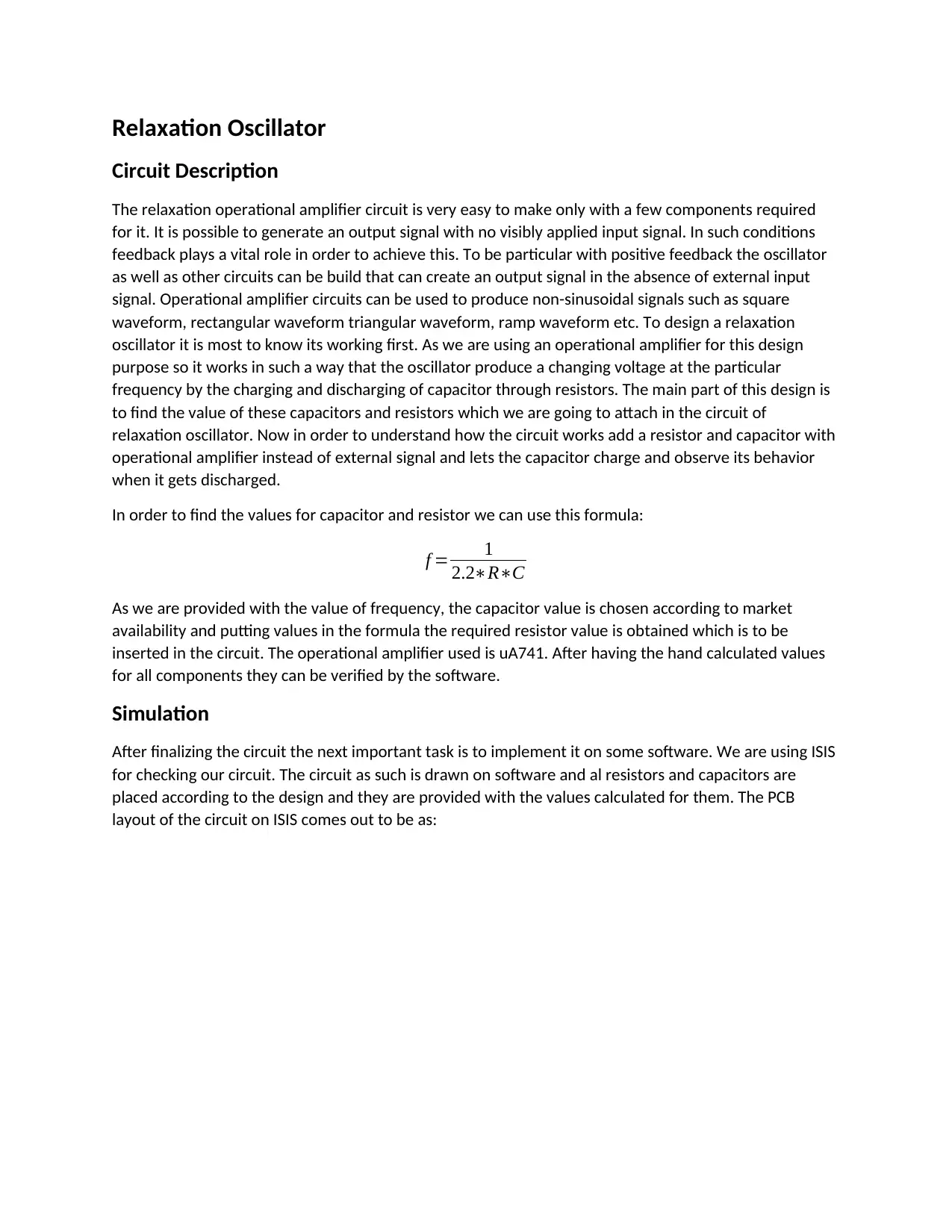
Relaxation Oscillator
Circuit Description
The relaxation operational amplifier circuit is very easy to make only with a few components required
for it. It is possible to generate an output signal with no visibly applied input signal. In such conditions
feedback plays a vital role in order to achieve this. To be particular with positive feedback the oscillator
as well as other circuits can be build that can create an output signal in the absence of external input
signal. Operational amplifier circuits can be used to produce non-sinusoidal signals such as square
waveform, rectangular waveform triangular waveform, ramp waveform etc. To design a relaxation
oscillator it is most to know its working first. As we are using an operational amplifier for this design
purpose so it works in such a way that the oscillator produce a changing voltage at the particular
frequency by the charging and discharging of capacitor through resistors. The main part of this design is
to find the value of these capacitors and resistors which we are going to attach in the circuit of
relaxation oscillator. Now in order to understand how the circuit works add a resistor and capacitor with
operational amplifier instead of external signal and lets the capacitor charge and observe its behavior
when it gets discharged.
In order to find the values for capacitor and resistor we can use this formula:
f = 1
2.2∗R∗C
As we are provided with the value of frequency, the capacitor value is chosen according to market
availability and putting values in the formula the required resistor value is obtained which is to be
inserted in the circuit. The operational amplifier used is uA741. After having the hand calculated values
for all components they can be verified by the software.
Simulation
After finalizing the circuit the next important task is to implement it on some software. We are using ISIS
for checking our circuit. The circuit as such is drawn on software and al resistors and capacitors are
placed according to the design and they are provided with the values calculated for them. The PCB
layout of the circuit on ISIS comes out to be as:
Circuit Description
The relaxation operational amplifier circuit is very easy to make only with a few components required
for it. It is possible to generate an output signal with no visibly applied input signal. In such conditions
feedback plays a vital role in order to achieve this. To be particular with positive feedback the oscillator
as well as other circuits can be build that can create an output signal in the absence of external input
signal. Operational amplifier circuits can be used to produce non-sinusoidal signals such as square
waveform, rectangular waveform triangular waveform, ramp waveform etc. To design a relaxation
oscillator it is most to know its working first. As we are using an operational amplifier for this design
purpose so it works in such a way that the oscillator produce a changing voltage at the particular
frequency by the charging and discharging of capacitor through resistors. The main part of this design is
to find the value of these capacitors and resistors which we are going to attach in the circuit of
relaxation oscillator. Now in order to understand how the circuit works add a resistor and capacitor with
operational amplifier instead of external signal and lets the capacitor charge and observe its behavior
when it gets discharged.
In order to find the values for capacitor and resistor we can use this formula:
f = 1
2.2∗R∗C
As we are provided with the value of frequency, the capacitor value is chosen according to market
availability and putting values in the formula the required resistor value is obtained which is to be
inserted in the circuit. The operational amplifier used is uA741. After having the hand calculated values
for all components they can be verified by the software.
Simulation
After finalizing the circuit the next important task is to implement it on some software. We are using ISIS
for checking our circuit. The circuit as such is drawn on software and al resistors and capacitors are
placed according to the design and they are provided with the values calculated for them. The PCB
layout of the circuit on ISIS comes out to be as:
Paraphrase This Document
Need a fresh take? Get an instant paraphrase of this document with our AI Paraphraser
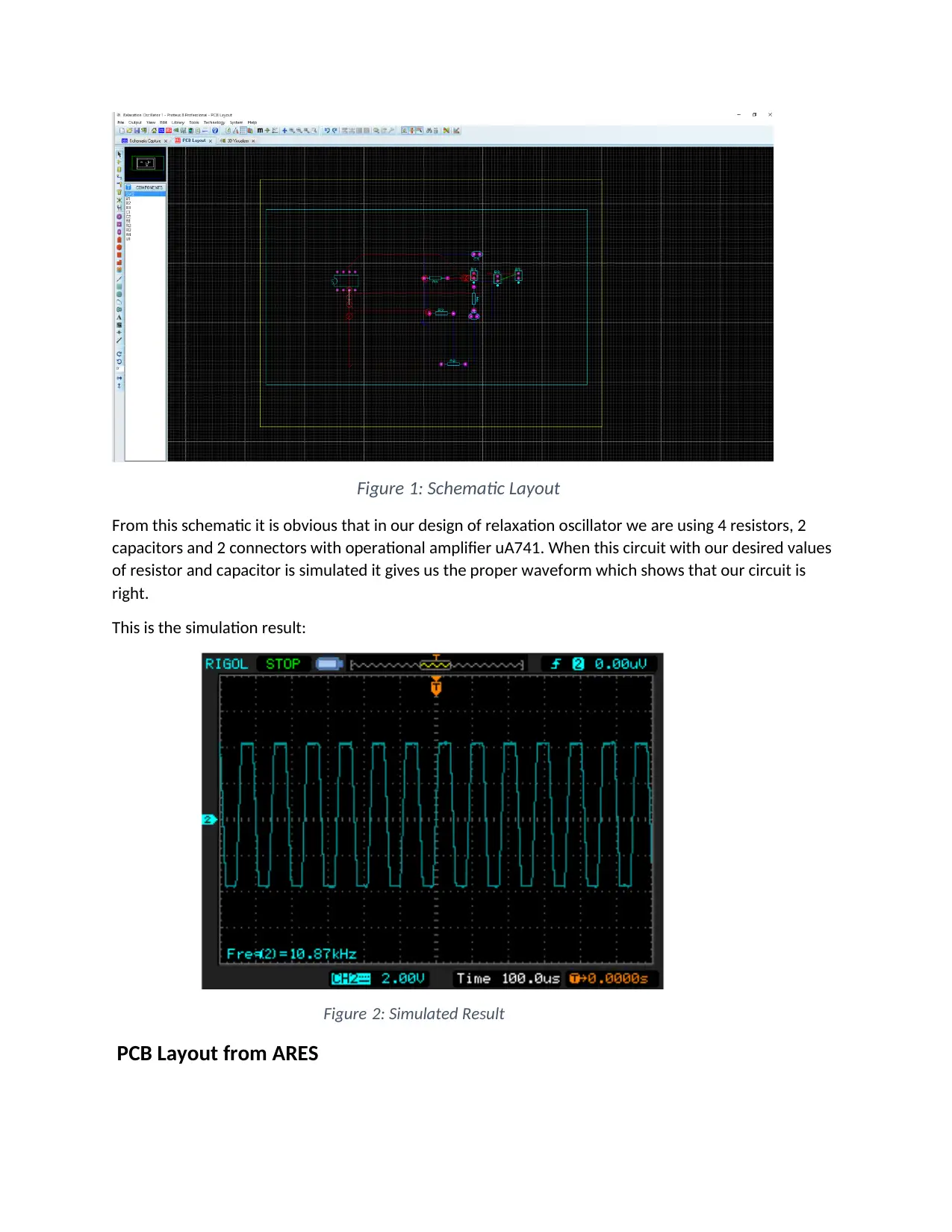
Figure 1: Schematic Layout
From this schematic it is obvious that in our design of relaxation oscillator we are using 4 resistors, 2
capacitors and 2 connectors with operational amplifier uA741. When this circuit with our desired values
of resistor and capacitor is simulated it gives us the proper waveform which shows that our circuit is
right.
This is the simulation result:
Figure 2: Simulated Result
PCB Layout from ARES
From this schematic it is obvious that in our design of relaxation oscillator we are using 4 resistors, 2
capacitors and 2 connectors with operational amplifier uA741. When this circuit with our desired values
of resistor and capacitor is simulated it gives us the proper waveform which shows that our circuit is
right.
This is the simulation result:
Figure 2: Simulated Result
PCB Layout from ARES
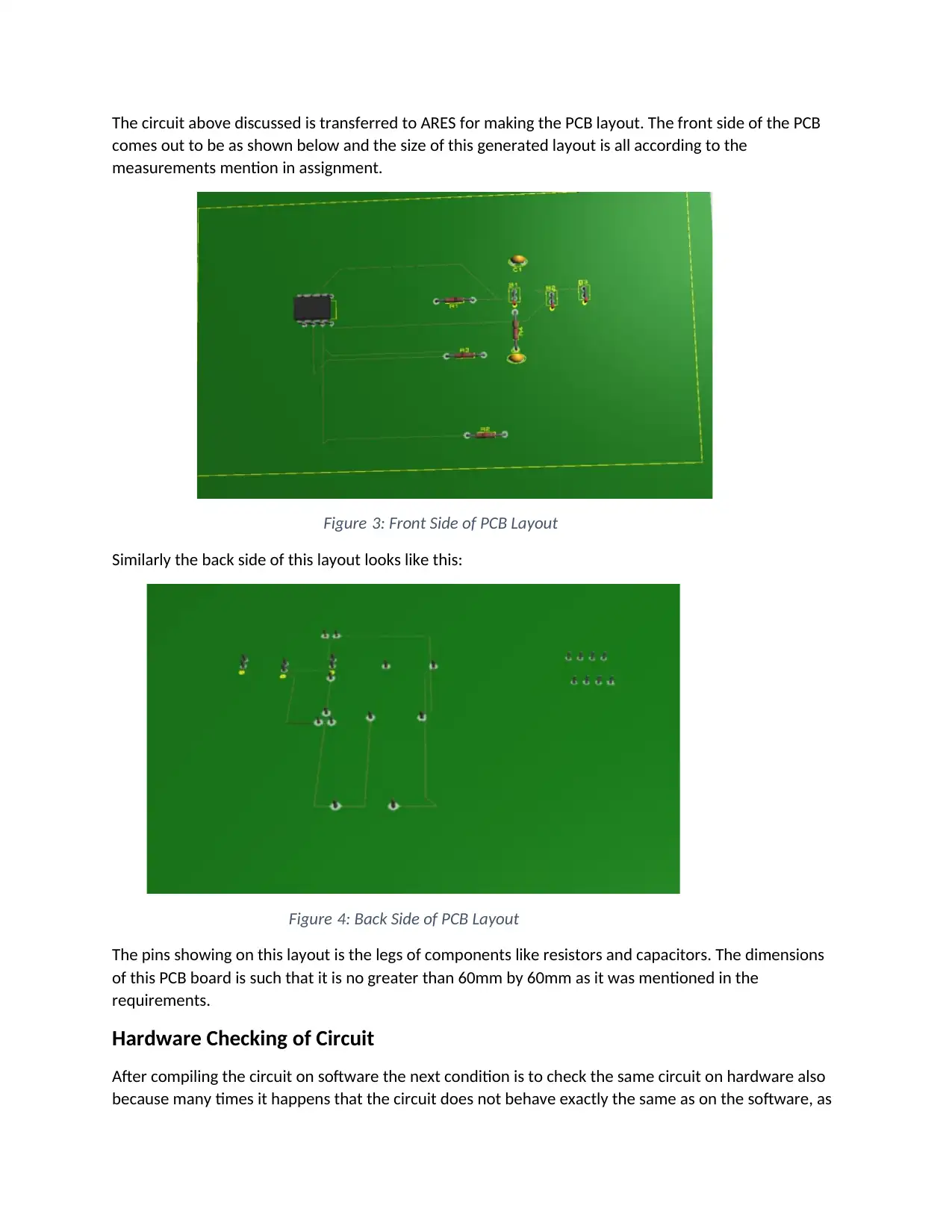
The circuit above discussed is transferred to ARES for making the PCB layout. The front side of the PCB
comes out to be as shown below and the size of this generated layout is all according to the
measurements mention in assignment.
Figure 3: Front Side of PCB Layout
Similarly the back side of this layout looks like this:
Figure 4: Back Side of PCB Layout
The pins showing on this layout is the legs of components like resistors and capacitors. The dimensions
of this PCB board is such that it is no greater than 60mm by 60mm as it was mentioned in the
requirements.
Hardware Checking of Circuit
After compiling the circuit on software the next condition is to check the same circuit on hardware also
because many times it happens that the circuit does not behave exactly the same as on the software, as
comes out to be as shown below and the size of this generated layout is all according to the
measurements mention in assignment.
Figure 3: Front Side of PCB Layout
Similarly the back side of this layout looks like this:
Figure 4: Back Side of PCB Layout
The pins showing on this layout is the legs of components like resistors and capacitors. The dimensions
of this PCB board is such that it is no greater than 60mm by 60mm as it was mentioned in the
requirements.
Hardware Checking of Circuit
After compiling the circuit on software the next condition is to check the same circuit on hardware also
because many times it happens that the circuit does not behave exactly the same as on the software, as
⊘ This is a preview!⊘
Do you want full access?
Subscribe today to unlock all pages.

Trusted by 1+ million students worldwide
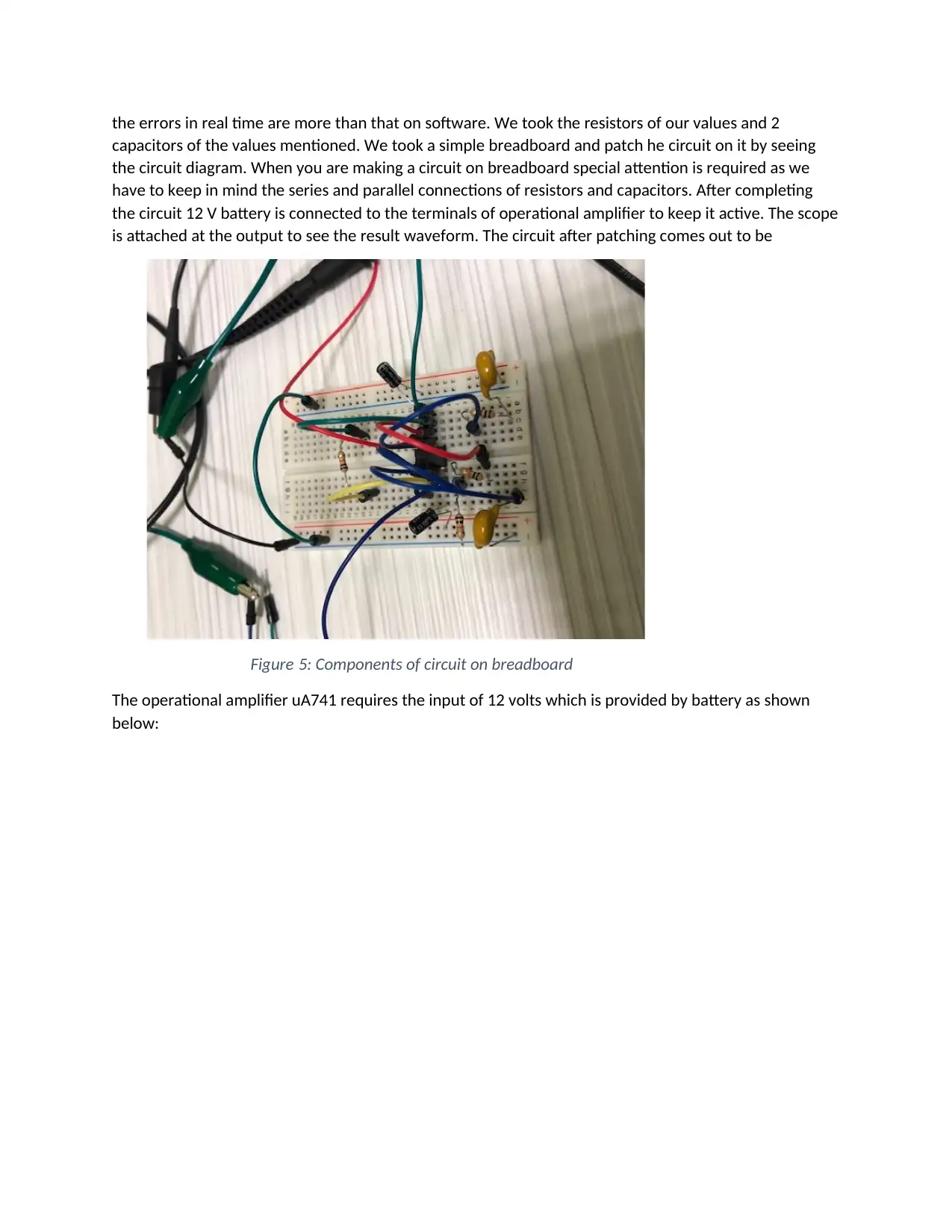
the errors in real time are more than that on software. We took the resistors of our values and 2
capacitors of the values mentioned. We took a simple breadboard and patch he circuit on it by seeing
the circuit diagram. When you are making a circuit on breadboard special attention is required as we
have to keep in mind the series and parallel connections of resistors and capacitors. After completing
the circuit 12 V battery is connected to the terminals of operational amplifier to keep it active. The scope
is attached at the output to see the result waveform. The circuit after patching comes out to be
Figure 5: Components of circuit on breadboard
The operational amplifier uA741 requires the input of 12 volts which is provided by battery as shown
below:
capacitors of the values mentioned. We took a simple breadboard and patch he circuit on it by seeing
the circuit diagram. When you are making a circuit on breadboard special attention is required as we
have to keep in mind the series and parallel connections of resistors and capacitors. After completing
the circuit 12 V battery is connected to the terminals of operational amplifier to keep it active. The scope
is attached at the output to see the result waveform. The circuit after patching comes out to be
Figure 5: Components of circuit on breadboard
The operational amplifier uA741 requires the input of 12 volts which is provided by battery as shown
below:
Paraphrase This Document
Need a fresh take? Get an instant paraphrase of this document with our AI Paraphraser
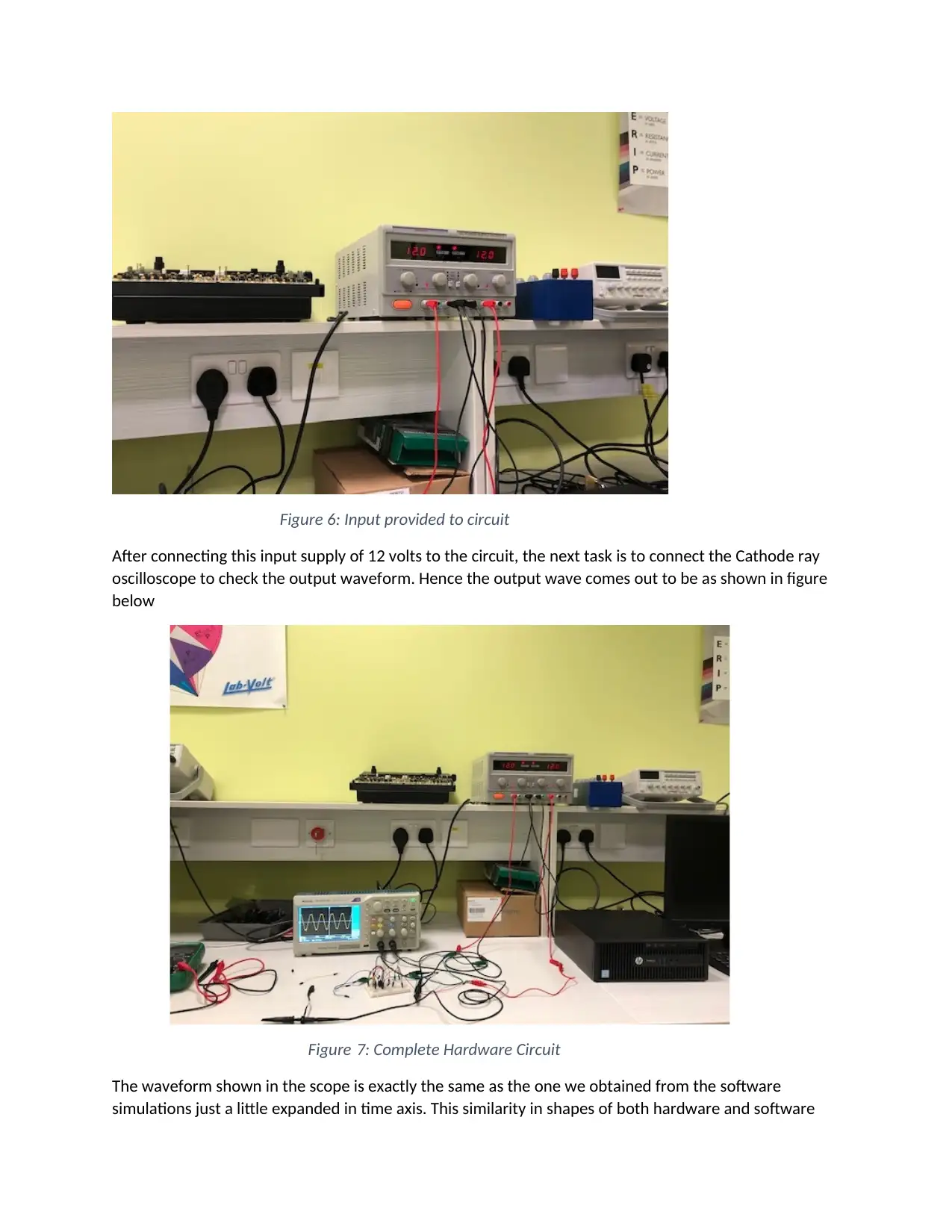
Figure 6: Input provided to circuit
After connecting this input supply of 12 volts to the circuit, the next task is to connect the Cathode ray
oscilloscope to check the output waveform. Hence the output wave comes out to be as shown in figure
below
Figure 7: Complete Hardware Circuit
The waveform shown in the scope is exactly the same as the one we obtained from the software
simulations just a little expanded in time axis. This similarity in shapes of both hardware and software
After connecting this input supply of 12 volts to the circuit, the next task is to connect the Cathode ray
oscilloscope to check the output waveform. Hence the output wave comes out to be as shown in figure
below
Figure 7: Complete Hardware Circuit
The waveform shown in the scope is exactly the same as the one we obtained from the software
simulations just a little expanded in time axis. This similarity in shapes of both hardware and software
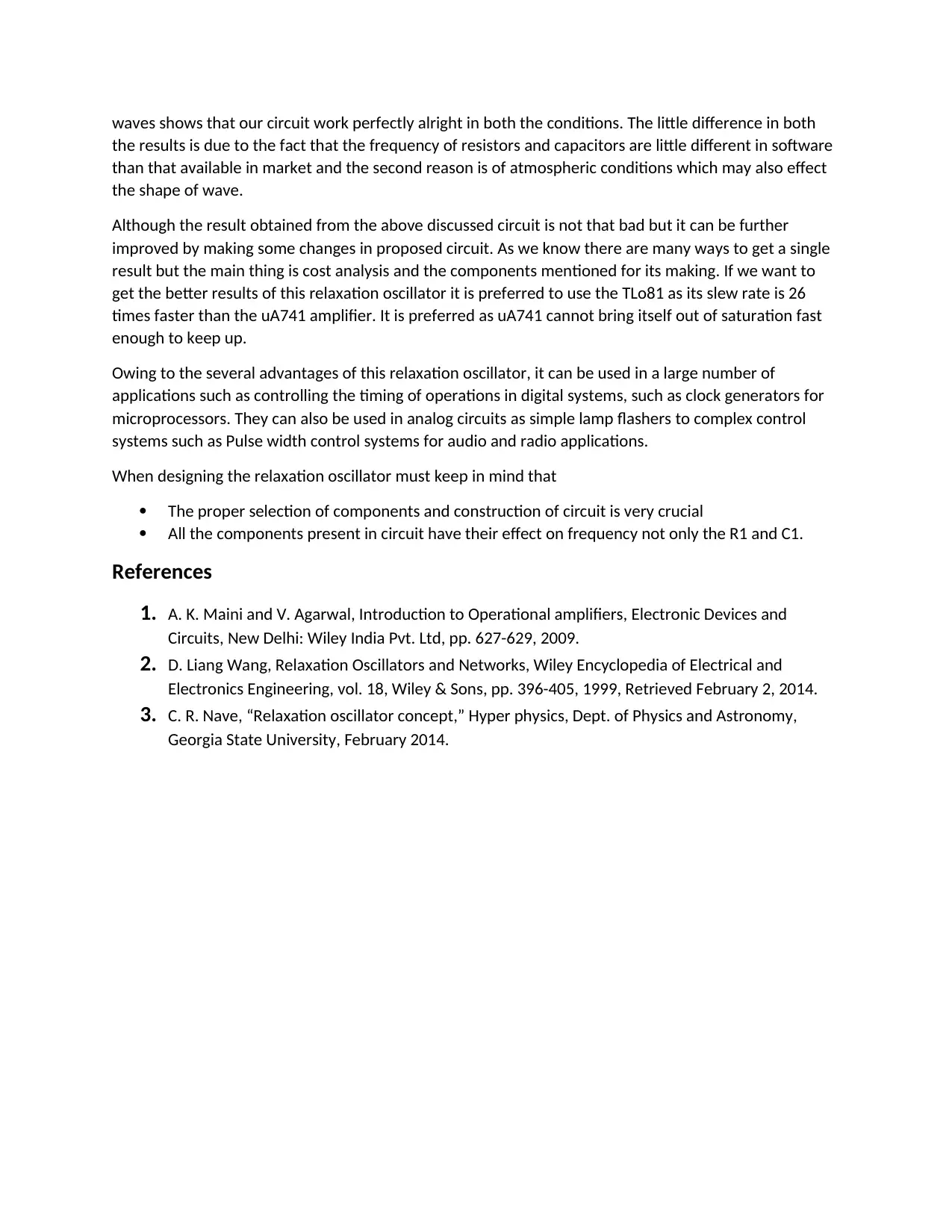
waves shows that our circuit work perfectly alright in both the conditions. The little difference in both
the results is due to the fact that the frequency of resistors and capacitors are little different in software
than that available in market and the second reason is of atmospheric conditions which may also effect
the shape of wave.
Although the result obtained from the above discussed circuit is not that bad but it can be further
improved by making some changes in proposed circuit. As we know there are many ways to get a single
result but the main thing is cost analysis and the components mentioned for its making. If we want to
get the better results of this relaxation oscillator it is preferred to use the TLo81 as its slew rate is 26
times faster than the uA741 amplifier. It is preferred as uA741 cannot bring itself out of saturation fast
enough to keep up.
Owing to the several advantages of this relaxation oscillator, it can be used in a large number of
applications such as controlling the timing of operations in digital systems, such as clock generators for
microprocessors. They can also be used in analog circuits as simple lamp flashers to complex control
systems such as Pulse width control systems for audio and radio applications.
When designing the relaxation oscillator must keep in mind that
The proper selection of components and construction of circuit is very crucial
All the components present in circuit have their effect on frequency not only the R1 and C1.
References
1. A. K. Maini and V. Agarwal, Introduction to Operational amplifiers, Electronic Devices and
Circuits, New Delhi: Wiley India Pvt. Ltd, pp. 627-629, 2009.
2. D. Liang Wang, Relaxation Oscillators and Networks, Wiley Encyclopedia of Electrical and
Electronics Engineering, vol. 18, Wiley & Sons, pp. 396-405, 1999, Retrieved February 2, 2014.
3. C. R. Nave, “Relaxation oscillator concept,” Hyper physics, Dept. of Physics and Astronomy,
Georgia State University, February 2014.
the results is due to the fact that the frequency of resistors and capacitors are little different in software
than that available in market and the second reason is of atmospheric conditions which may also effect
the shape of wave.
Although the result obtained from the above discussed circuit is not that bad but it can be further
improved by making some changes in proposed circuit. As we know there are many ways to get a single
result but the main thing is cost analysis and the components mentioned for its making. If we want to
get the better results of this relaxation oscillator it is preferred to use the TLo81 as its slew rate is 26
times faster than the uA741 amplifier. It is preferred as uA741 cannot bring itself out of saturation fast
enough to keep up.
Owing to the several advantages of this relaxation oscillator, it can be used in a large number of
applications such as controlling the timing of operations in digital systems, such as clock generators for
microprocessors. They can also be used in analog circuits as simple lamp flashers to complex control
systems such as Pulse width control systems for audio and radio applications.
When designing the relaxation oscillator must keep in mind that
The proper selection of components and construction of circuit is very crucial
All the components present in circuit have their effect on frequency not only the R1 and C1.
References
1. A. K. Maini and V. Agarwal, Introduction to Operational amplifiers, Electronic Devices and
Circuits, New Delhi: Wiley India Pvt. Ltd, pp. 627-629, 2009.
2. D. Liang Wang, Relaxation Oscillators and Networks, Wiley Encyclopedia of Electrical and
Electronics Engineering, vol. 18, Wiley & Sons, pp. 396-405, 1999, Retrieved February 2, 2014.
3. C. R. Nave, “Relaxation oscillator concept,” Hyper physics, Dept. of Physics and Astronomy,
Georgia State University, February 2014.
⊘ This is a preview!⊘
Do you want full access?
Subscribe today to unlock all pages.

Trusted by 1+ million students worldwide
1 out of 6
Related Documents
Your All-in-One AI-Powered Toolkit for Academic Success.
+13062052269
info@desklib.com
Available 24*7 on WhatsApp / Email
![[object Object]](/_next/static/media/star-bottom.7253800d.svg)
Unlock your academic potential
Copyright © 2020–2025 A2Z Services. All Rights Reserved. Developed and managed by ZUCOL.




